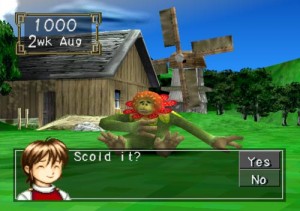Top 5 Cult RPG Video Games
My definition of “cult” in reference to media means that while a game or movie did not experience huge commercial success, it achieved a dedicated fan base. Some of these games may even be critically acclaimed, but for some reason never resonated with the general public. If you ask someone off the street and they have never heard of it, then chances are I would consider it cult. The games I selected below were those that I sank hundreds of hours, but have no one to discuss them with since they weren’t too popular.
5. Dark Cloud (2001) for PlayStation 2
An action RPG from the Playstation 2’s early days. Dark Cloud had two interesting features that made it stand out. First, rather than leveling characters normally, weapons would level up by defeating enemies. You also had to be careful because weapons could break if they were not properly maintained. Second, DC used a system reminiscent of the old SNES game “ActRaiser” where towns must be rebuilt (using items found in dungeons) and arranged optimally to please residents and unlock special items. This feature really broke up game play and created new dimensions. Overall, this game offered solid action and variable game play so it was easy to sink many hours into.
4. Monster Rancher (1997) for PlayStation
The original Monster Rancher game for the PS1 had an interesting gimmick. New monsters could be found by inserting any CD into the system. This game also allowed you to combine monsters into new and stronger creatures. Much of the game was based on training or monster and fighting in the areas or exploring treacherous dungeons. One issue with this gimmick was that once enough people experimented, it was fairly easy to pick up whichever CD gave you the most powerful monster, essentially breaking the game. Despite that, it was still fun to see which of your favorite albums gave you an interesting monster. The emotional devastation experienced when the monster you have been raising dies due to old age or the wounds received while on an adventure is second to none.
3. Bravely Default (2014) for Nintendo 3DS
Bravely Default is the spiritual successor to “Final Fantasy: Four Warriors of Light”. This game is a JRPG fan’s dream. The most interesting thing about this title is that it gave you the ability to control monster encounter rates and whether you wanted to earn experience or gold during battle. In the world of challenges like low level, one character and speed runs, these settings make this game very convenient for the type of people looking for that kind of experience. Plus, this was convenient for those of us who don’t mind grinding, but would rather not deal with random encounters when fighting bosses or exploring dungeons. This game also featured a great story that twists classic RPG tropes and a class system that’s as enjoyable as any classic Final Fantasy game. With the direction that FF has been going, Bravely Default is a sight for sore eyes.
2. Dragon Quest Monsters (also known as Dragon Warrior Monsters) (1999) for Gameboy Advanced
It was considered by many to be just another Pokemon clone, but with Dragon Quest characters slapped over the top. I’m not exactly opposed to this kind of game design, but the core mechanics were very different. While Pokemon encouraged catching rare monsters, the rarest monsters in DQM could only be obtained by intricate breeding regimens. Monsters also learned skills depending on their base monster type and their pedigree. Another aspect of DQM was the option to allow the AI to control your monsters in each battle. This made level grinding more tolerable because you could have your monster focus on healing or never use MP. Ultimately, I would recommend this game to anyone who loves party customization and Dragon Quest games.

Don’t worry about him, he’s just a small child wandering around volcanoes and harnessing the power of giant beasts. NBD.
1. SaGa Frontier (1998) for PlayStation
The SaGa franchise has had a huge following in Japan, but Americans seem fairly cold to it. What sets SaGa frontier different from the usual RPGs is its multiple story line system. You can pick one of seven characters each with their own intertwined segment, completing the game once each story is complete. What I found most entertaining was how each location would give a different experience depending on whose quest you were completing. New enemies might appear or different options for quests would be available. Worlds that you might stop by quickly as one character would be pivotal in another’s. Plus, there was the interesting monster system, whereby a monster character can gain new forms depending on the abilities it absorbed from an enemy. This game had a lot to do and plenty of ways to play it.
Make sure to check out Ryan and Kyle’s lists as well!
-Garion






Pingback: Roll the List #37: Kyle’s Take | Aeither.net
Pingback: Roll the List #37: Ryan’s Take | Aeither.net